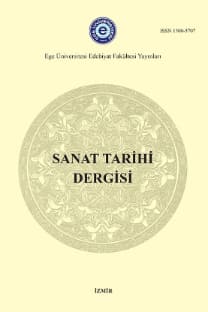Hristiyan Sanatı Bağlamında Yakup Hikayesi’ndeki Cariyeler
Cariye, Yakup, Hıristiyan sanatı, Zilpa, Bilha
The Handmaids of Jacob’s Story in the Context of Christian Art
Handmaid, Jacob, Christian art, Zilpah, Bilhah,
___
- Albright W. F. (1918). Historical and Mythical Elements in the Story of Joseph. Journal of Biblical Literature. Vol. 37, No. ¾, 111-143.
- Block D. I. (2003). Marriage and Family in Ancient Israel. In Campbell, K. M. (Ed.). Marriage and Family in the Biblical World. pp. 33-103. USA: InterVasity Press.
- Botterweck G. J., Ringgren H., & Fabry H. J. (Ed.) (2001). Theological Dictionary of the Old Testament. Vol XI, Grand Rapids: William B. Eerdmans Publishing Company.
- Brenner A. (1986). Female Social Behaviour: Two Descriptive Patterns within the “Birth of the Hero” Paradigm. Vetus Testamentum. Vol. 36, Fasc. 3, 257-273.
- Cutler A. (1998). Late Antique and Byzantine Ivory Carving. Collected Studies, 617 Variorum.
- Friedlander G. (Trans.) (1916). Rabbi Eliezer. Pirke De Rabbi Eliezer. London: Kegan Paul, Trench, Turner & Co. Ltd.
- Joslin M.C. & Watson C.J. (2001). The Egerton Genesis. The British Library University of Toronto Press. JWA Encyclopedia (https://jwa.org/encyclopedia/article/rashi)
- Kramer, P. S.(1998). Biblical Women that Come in Pairs: The Use of Female Pairs as a Literary Device in the Hebrew Bible. (ed. Brenner A.) Genesis: A Feminist Companion to the Bible. FCB2 1; Sheffield: Sheffield Academic Press.
- Leonhardt Joy K. (2004). And as for Sarai...” First Wives and the Inheritance of Land In the Promise Narratives of Genesis (Master of Arts). University of Alberta.
- Levin D. M. (1972). Some Jewish Sources for the Vienna Genesis. The Art Bulletin. Vol. 54, No. 3, 241-244.
- Liddell H. G. & Scott R. (Ed.) (1901). Greek-English Lexicon. Oxford: Clarendon Press.
- Lowden J. (1992). Concerning the Cotton Genesis and Other Illustrated Manuscripts of Genesis. Gesta, Vol. 31, No. 1, 40-53.
- Luttikhuizen H. & Verkerk D. (2006) Snyder’s Medieval Art. 2nd ed., (Upper Saddle River, NJ: Prentice Hall.
- Moss, C. R. & Baden, J. S. (2015). Reconceiving Infertility Biblical Perspectives on Procreation and Childlessness. Princeton: Princeton University Press.
- Potts, C. A. (1922). Dictionary of Bible Proper Names; Every Proper Name in the Old and New Testaments Arranged in Alphabetical Order; Syllabified and Accented; Vowel Sounds Diacritically Marked; Definitions Given in Latin and English. New York: Abingdon Press
- Spanier, K. (1989). Aspects of Fratriarchy in the Old Testament (Ph.D. dissertation). New York University.
- Stone, M. E. (1996). The Genealogy of Bilhah. Dead Sea Discoveries. Vol. 3, No. 1, 20-36. Vatican Library (https://digi.vatlib.it/view/MSS_Vat.gr.747)
- Von Rad G. (1972). Genesis A Commentary (Revised Edition). London: SCM Press LTD.
- Weitzmann, K. & Bernabò, M. (1999). The Byzantine octateuchs: Mount Athos, Vatopedi Monastery, codex 602; Florence, Biblioteca Medicea Laurenziana, Codex Pluteus 5.38; Istanbul, Topkapi Sarayi Library, codex G. I. 8; Rome, Biblioteca Apostolica Vaticana, Codex Vaticanus Graecus 746 and Codex Vaticanus Graecus 747; Smyrna (olim), Evangelical School Library, codex A. 1. Text. Princeton, NJ: Princeton Univ. Pr.
- Weitzmann, K. & Kessler, H. (1986). The cotton genesis: British Library, Codex Cotton Otho B. VI. Princeton. NJ: Princeton Univ. Press
- Wevers, J. W. (1974). Septuaginta: Vetus Testamentum Graecum. 1. Genesis. Göttingen: Vandenhoeck & Ruprecht.
- ISSN: 1300-5707
- Yayın Aralığı: 2
- Başlangıç: 1982
- Yayıncı: Ege Üniversitesi, Edebiyat Fakültesi
Hristiyan Sanatı Bağlamında Yakup Hikayesi’ndeki Cariyeler
Yeni Veriler Işığında Akhisar Gülruh Sultan Camii ve Restorasyon Önerileri
Sirarpie Der Nersessian’ın Sanat Tarihi Metodolojisi
Vedad Tek’in Sarayburnu Rıhtımı Düzenlemesi
Kavramsal Altyapılarının Tarihsel Gelişimi Bağlamında Sanat İnisiyatifleri
Kültürel Tasarım Mirasınının Zanaat Nesneleriyle Geleceğe Aktarılması
Bir Osmanlı Aydınının 105 Yıl Önce Kaleme Aldığı İlk Sanat Tarihi Kitaplarından: Mübeccel Hazineler
Turfan Uygurlarının Mahayana Budist Maddi Kültürüne ve Sanat Rönesansına Katkıları
